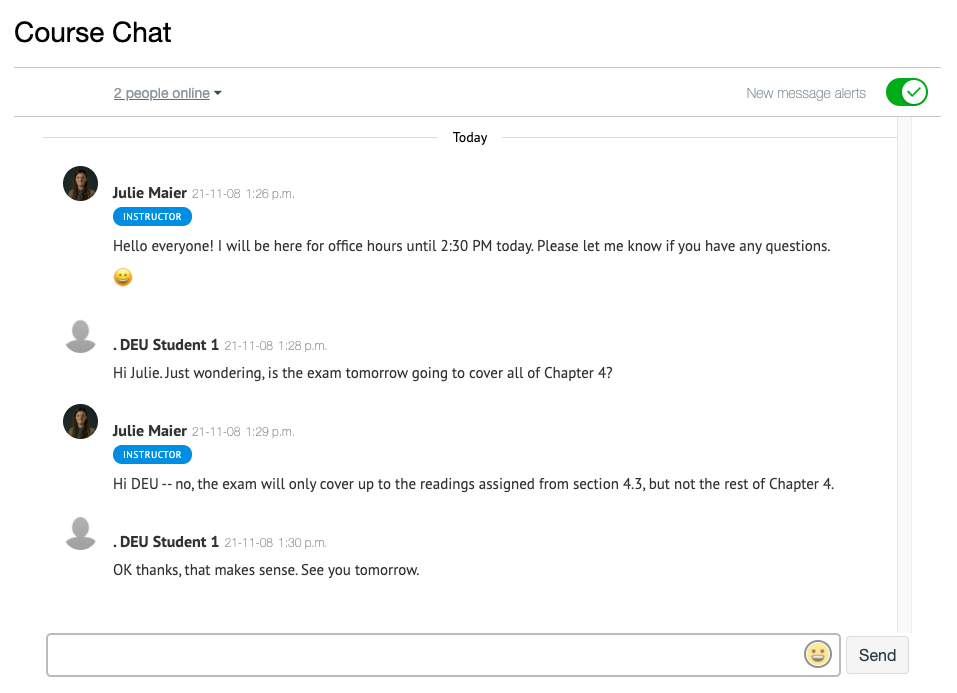The Chat tool in Canvas is a very simple and low-bandwidth real-time communication option that, if used deliberately, could provide a quick and easy-to-access way to aid communication in your class, improve your presence as an online instructor, or be a convenient way to structure engaging learning activities in your blended course.
This post will include a brief overview of the Chat tool, and cover a few ideas for incorporating it into your online or blended teaching plans.
What is the Chat tool?
Chat is a course tool that is available to all students, instructors, and TAs in the course, and can be used for real-time conversation with course users. Chats cannot be limited to specific students, but rather puts all users together into a centralized real-time feed.
Any users with the Chat tool currently open will also appear visible in the “Online user list” (although direct or private messages are not possible in the Chat tool):
Users who submit a comment to the Chat can share simple text messages, emojis, or URLs (which become clickable hyperlinks). The Chat history also remains with the course, and all users can access that as well. Note that students cannot delete Chat comments (even their own), but the instructor can.
How could I use the Chat tool?
To make the most of the Chat tool, users should be active and present in a real-time scenario. There are ways to use this for both online synchronous and in-person situations; here are a few ideas to get you started on thinking about how you might use this tool in your own teaching context.
1. Virtual office hours
Add the time and date for virtual office hours into your course calendar and/or syllabus, and direct students to join (optionally) via the Canvas Chat tool. As instructor, you can open Chat at the start of office hours and leave the Chat window open (or minimized with “New message alerts” turned ON) and respond if/when students drop in to ask questions.
2. Group discussions
The Chat tool could be a useful alternative to the Discussion boards if you are looking for a faster, less structured, and more real-time conversation tool. However, be mindful that with large groups, the Chat feed could be overwhelming or difficult to follow; this would only be a good option for smaller groups and/or for shorter sessions.
3. Background conversation during study or group work sessions
Another option is to use the Chat feed as an optional “background conversation feed” during study or group work sessions. Students might work independently for part of the time, but drop into/out of the live Chat session if and when they have a question or need a bit of help with something.
4. Collect pre-discussion questions from students
A good option for blended classes is to use the Chat feed to collect pre-discussion questions from your students. For example, you might ask your students at the start of class to post into the Chat a question or two that they have based upon the assigned readings for that class. If your students are typically coming to class with a device (laptop or mobile), you can begin your class with this type of activity.
5. Supplement large in-person classes with a live digital communication option
The Chat tool could be used to increase student engagement in large classes by giving another way for students to submit questions, share comments, or participate in class discussions. In such a situation, you may wish to have an assistant (TA or perhaps a student volunteer) who can help with monitoring the chat and alerting the instructor to particularly insightful comments or pertinent questions.
6. Perform a quick full-class brainstorm session
Another fast way to use the tool in your in-person (blended) class would be to ask students to submit ideas into the Chat feed during brainstorming sessions or other open-response question activities; you can then do a quick scan of the incoming results (or even display them via a projector in your classroom) and use this as a basis to structure the subsequent live discussion.
Other tips for using the Chat tool
-
- Make sure the Chat tool has been made visible in your course menu. If it has not been enabled in the menu, students will not be able to access it. For more information, see: How do I manage Course Navigation links?
- Toggle the “New message alerts” button to ON (see the upper-right-hand side of the screen) if you would like to get a small alert (a chiming sound) when another user adds a new Chat comment. Note that this only works when Chat is not in the active browser window, so this could be a good option if you wish to keep the Chat open in a minimized window while you work in another program.
- Currently there is no load limit for a course chat, but larger numbers of course users may affect performance.
- Students can use the Chat tool even without the instructor being present; let them know about the availability of this tool if you think it will be helpful to them outside of any meeting times scheduled for the entire class (e.g., for group work or shared projects).
- Make sure your students understand that Chat is not the place for private or sensitive conversations, and that their comments can be seen by all. Canvas Inbox or email is a better place for private conversations.
For more information on the Canvas Chat tool, see the following pages in the Canvas user documentation:
Photo by Christina Morillo from Pexels



